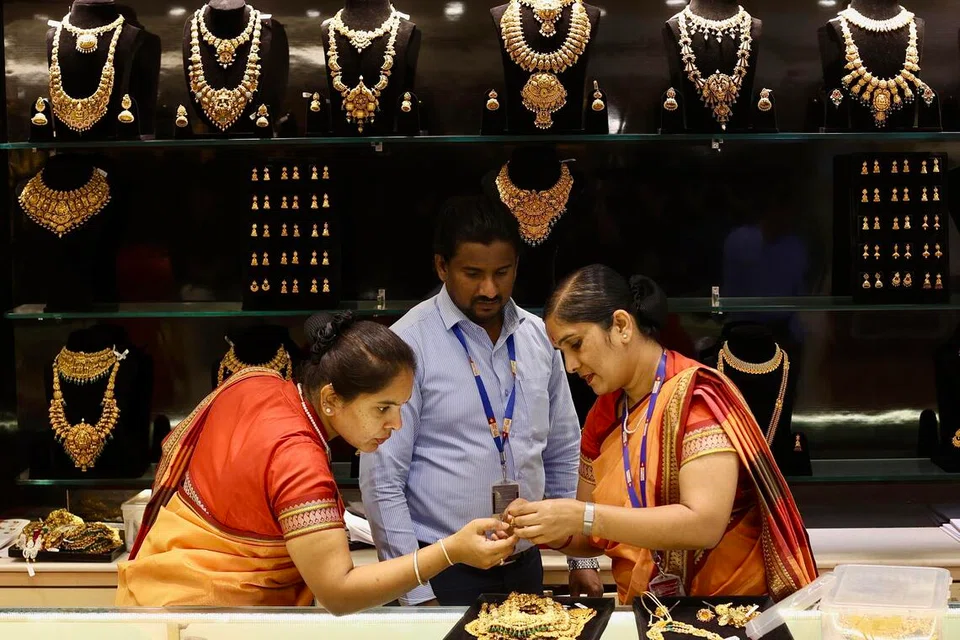In Delhi’s bustling Lajpat Nagar, the air ahead of Deepavali shimmered not only with fairy lights but with the glint of gold. Jewellery shops overflowed with eager buyers, their displays gleaming under garlands of marigolds.
Despite gold prices soaring to record highs – surpassing Rs1.32 lakh (S$1,953) per 10 grams – Indians were once again indulging in their age-old festive ritual of buying the precious metal. The prices, however, fell sharply on Oct 22 to Rs1.27 lakh, marking the fourth straight day of decline and offering relief to retail shoppers after the festive surge.
For millions across India, Deepavali, and the preceding Dhanteras (a celebration aimed at increasing wealth and prosperity) remain the most auspicious days to buy gold and silver, believed to bring prosperity and good luck.
The tradition endured this year too, even as prices have surged more than 60 per cent for gold and 70 per cent for silver over the past year.
“People are afraid prices will rise even more, so they were buying – that drove the rush,” Mr Prakash Pahlajani, owner of Kumar Jewels, told the BBC. His shop stayed open late every night, catering to long queues of customers.
But this year’s shoppers were more strategic. “Customers weren’t saying, ‘I won’t buy.’ They were saying, ‘I’ll buy less,’” said jeweller Tanishq Gupta. He offered thinner gold coins – some weighing just 250 milligrams – designed to look larger than they are. Even 25mg coins, priced around Rs2,000, found a market among first-time buyers and young professionals.
Retailers said younger customers wanted sleek, wearable pieces over ornate designs. “Lighter jewellery is the big trend,” noted Mr Pushpinder Chauhan, another Delhi jeweller. “Buyers want something they can wear daily, not just lock away for weddings.”
Despite high prices, this year’s Dhanteras sales defied expectations. The All India Gem and Jewellery Domestic Council (GJC) estimated that overall gold and silver sales crossed Rs60,000 crore (S$887 million), up 25 per cent in value from last year, though volumes dipped by about 10-15 per cent.
Shoppers focused on smaller, more affordable purchases – coins, bars, and lightweight ornaments. “Gold coins between one and 50 grams sold briskly,” said Mr Rajesh Rokde, GJC chairman. “Silver outshone gold – sales of silver coins rose 35-40 per cent year-on-year.”
Jewellery chains like Senco Gold & Diamonds and PNG Jewellers confirmed the trend. “Volume declined 12 per cent, but value rose over 20 per cent,” said Senco CEO Suvankar Sen, adding that the silver business had more than doubled. “Consumers are adapting – they’re buying smart.”
For families preparing for weddings, however, affordability remains a challenge. “I’m delaying my jewellery shopping,” said Ms Bhavna, a bride-to-be in Delhi. “I can’t skip buying gold entirely – it’s part of our rituals – but I’ll buy smaller pieces for now.”
This Deepavali, silver emerged as the more accessible metal of choice. Coin sales surged by up to 40 per cent, particularly in smaller towns.
Analysts say the white metal’s lower entry cost and dual role – as an investment and an auspicious gift – make it increasingly attractive to younger and middle-income buyers.
Even as global prices soar, India’s fascination with gold and silver remains unshaken. The forms may change – from heavy bridal necklaces to minimalist chains, from ornate bangles to digital gold – but the sentiment endures.
As economist Madan Sabnavis of Bank of Baroda summed it up: “For the affluent, gold is a luxury; for the middle class, it’s security; and for India, it’s identity. The price may rise, but the tradition doesn’t fade.”

